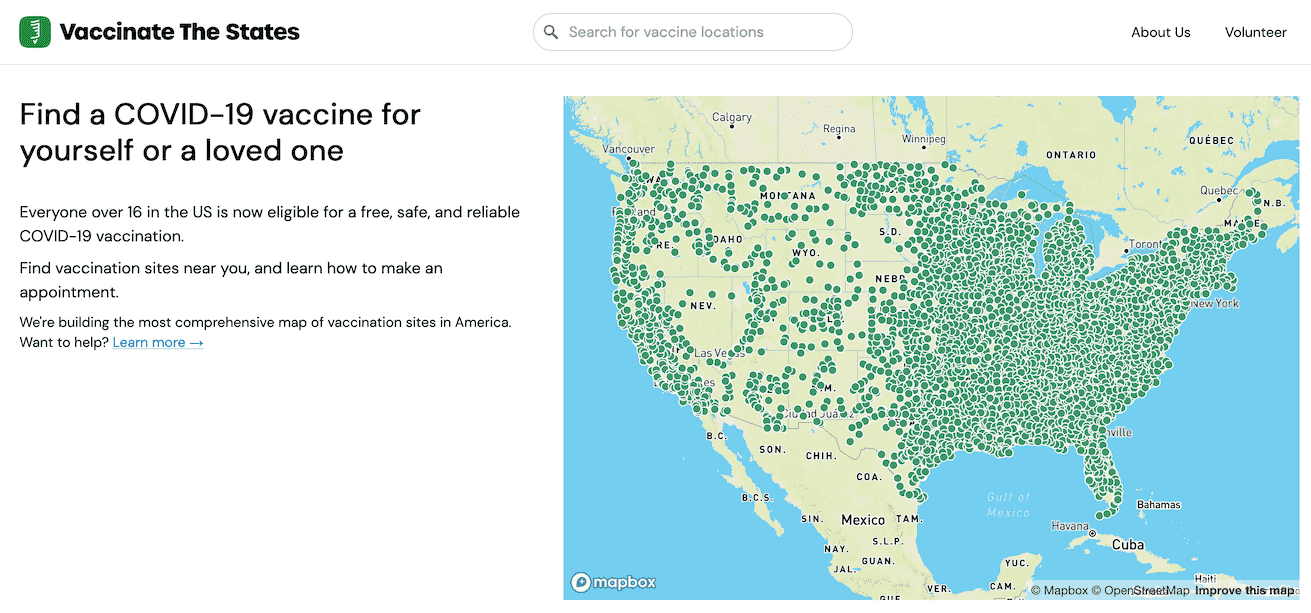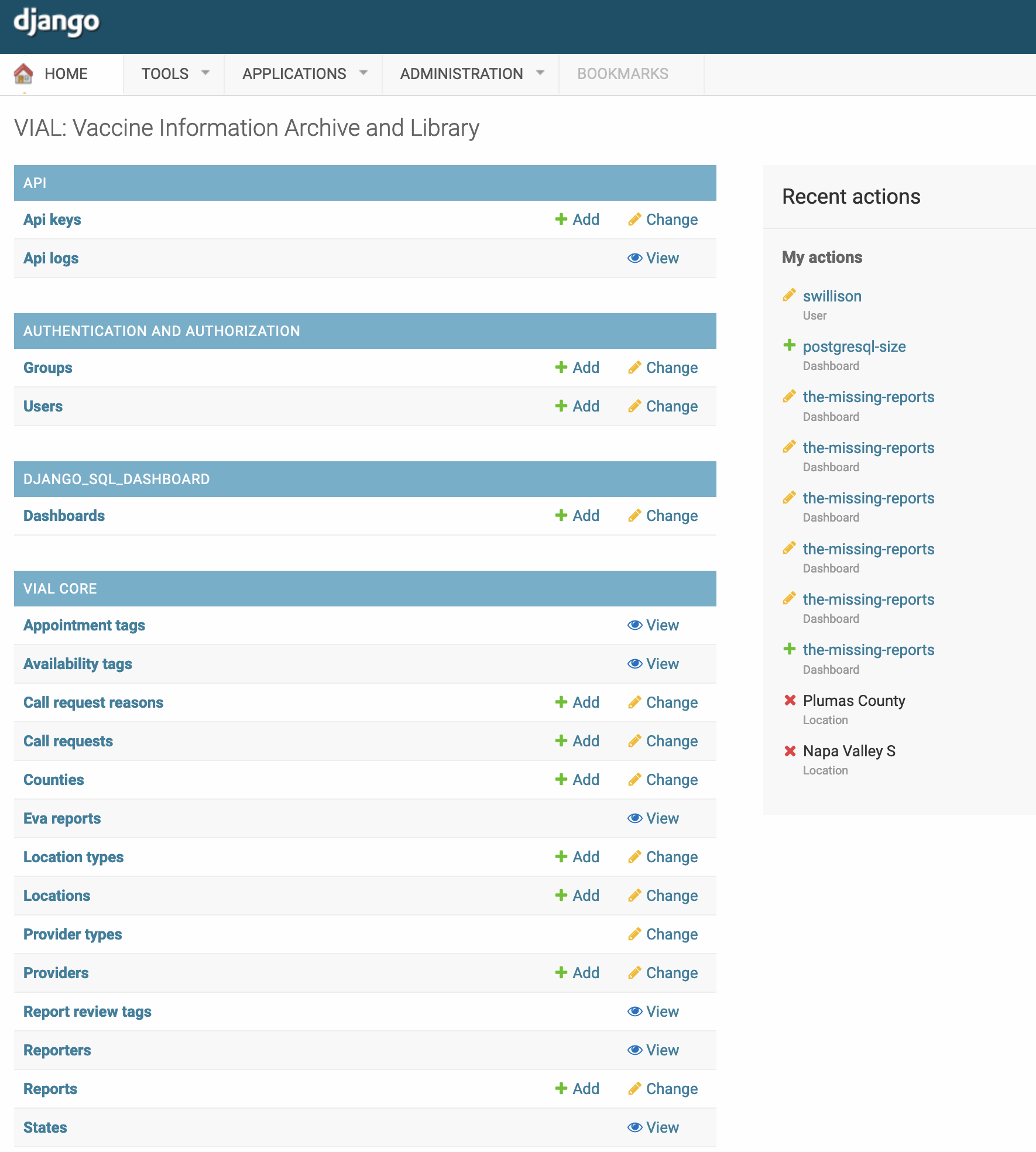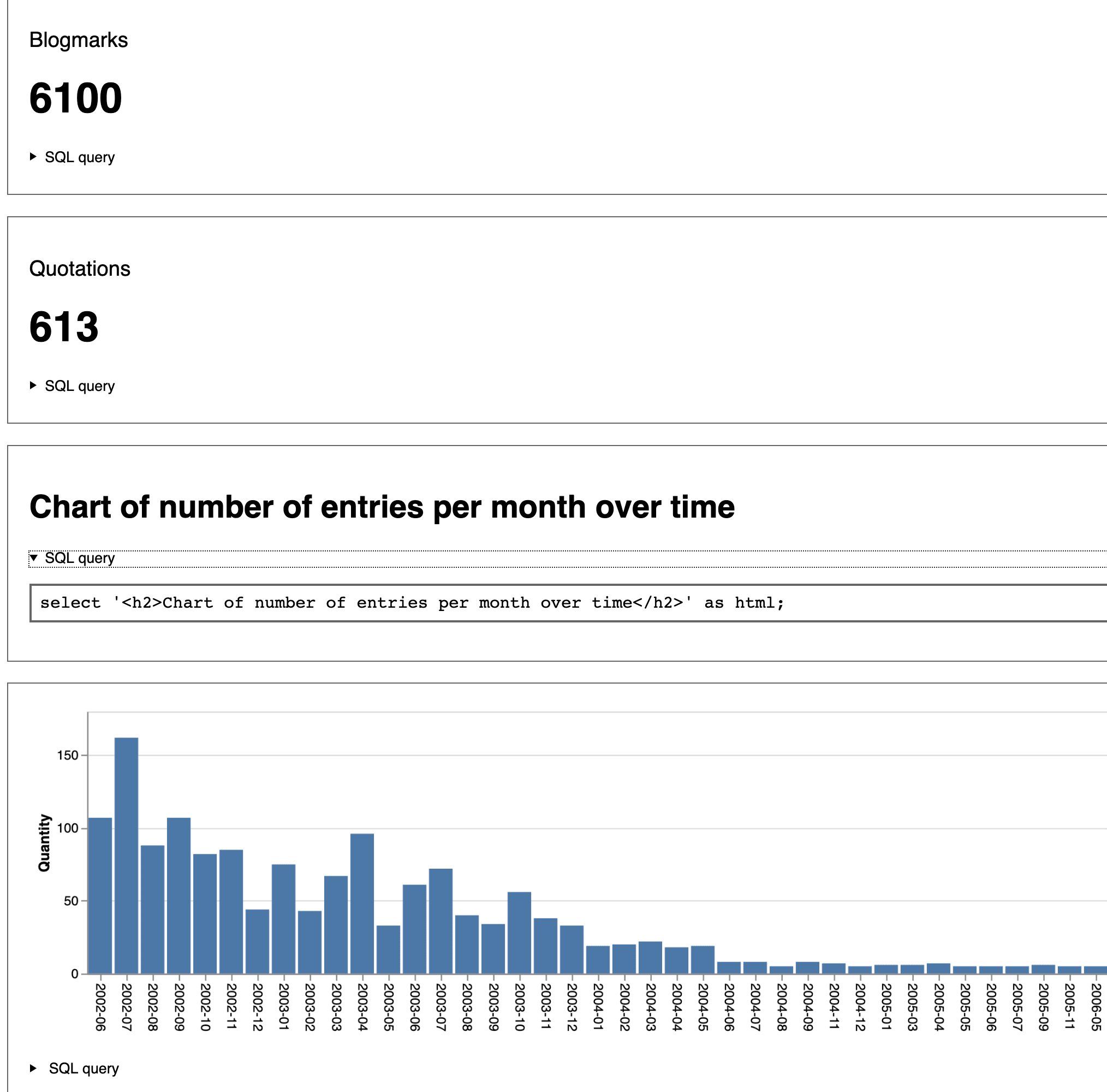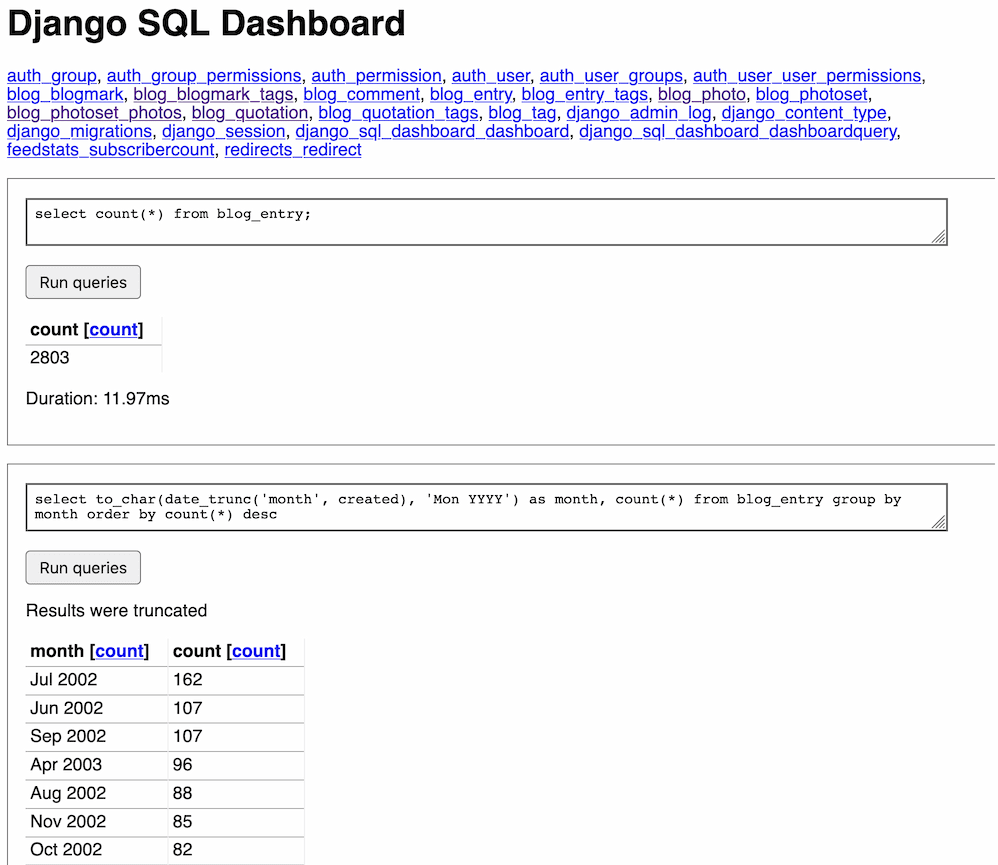582 posts tagged “django”
The Django web framework.
2021
Weeknotes: Vaccinate The States, and how I learned that returning dozens of MB of JSON works just fine these days
On Friday VaccinateCA grew in scope, a lot: we launched a new website called Vaccinate The States. Patrick McKenzie wrote more about the project here—the short version is that we’re building the most comprehensive possible dataset of vaccine availability in the USA, using a combination of data collation, online research and continuing to make a huge number of phone calls.
[... 1,109 words]Porting VaccinateCA to Django
As I mentioned back in February, I’ve been working with the VaccinateCA project to try to bring the pandemic to an end a little earlier by helping gather as accurate a model as possible of where the Covid vaccine is available in California and how people can get it.
[... 2,157 words]Weeknotes: django-sql-dashboard widgets
A few small releases this week, for django-sql-dashboard, datasette-auth-passwords and datasette-publish-vercel.
Weeknotes: tableau-to-sqlite, django-sql-dashboard
This week I started a limited production run of my new backend for Vaccinate CA calling, built a tableau-to-sqlite import tool and started working on a subset of Datasette for PostgreSQL and Django called django-sql-dashboard.
Drawing the rest of the owl
My ambitious goal for the day was to get the new Django/PostgreSQL preview into a state where we could start sending example API requests to it from the help.vaccinate app.
Trying to end the pandemic a little earlier with VaccinateCA
This week I got involved with the VaccinateCA effort. We are trying to end the pandemic a little earlier, by building the most accurate database possible of vaccination locations and availability in California.
[... 1,154 words]Django admin customization, JSON in our PostgreSQL
My progress slowed a bit today as I started digging into some things I’m less familiar with—but I’ve found some tricks that I think will help us out a lot.
[... 1,089 words]Importing data from Airtable into Django, plus a search engine for all our code
I made a bunch of progress on the Django backend prototype-that-soon-won’t-be-a-prototype today.
[... 935 words]Spinning up a new Django app to act as a backend for VaccinateCA
My goal by the end of this week is to have a working proof of concept for a Django + PostgreSQL app that can replace Airtable as the principle backend for the https://www.vaccinateca.com/ site. This proof of concept will allow us to make a go or no-go decision and figure out what else needs to be implemented before we can start using it to track calls.
[... 762 words]2020
The trouble with transaction.atomic (via) David Seddon provides a detailed explanation of Django’s nestable transaction.atomic() context manager and describes a gotcha that can occur if you lose track of whether your code is already running in a transaction block, since you may be working with savepoints instead—along with some smart workarounds.
Bedrock: The SQLitening (via) Back in March 2018 www.mozilla.org switched over to running on Django using SQLite! They’re using the same pattern I’ve been exploring with Datasette: their SQLite database is treated as a read-only cache by their frontend servers, and a new SQLite database is built by a separate process and fetched onto the frontend machines every five minutes by a scheduled task. They have a healthcheck page which shows the latest version of the database and when it was fetched, and even lets you download the 25MB SQLite database directly (I’ve been exploring it using Datasette).
Inevitably we got round to talking about async.
As much of an unneeded complication as it is for so many day-to-day use-cases, it’s important for Python because, if and when you do need the high throughput handling of these io-bound use-cases, you don’t want to have to switch language.
The same for Django: most of what you’re doing has no need of async but you don’t want to have to change web framework just because you need a sprinkling of non-blocking IO.
Pysa: An open source static analysis tool to detect and prevent security issues in Python code (via) Interesting new static analysis tool for auditing Python for security vulnerabilities—things like SQL injection and os.execute() calls. Built by Facebook and tested extensively on Instagram, a multi-million line Django application.
James Bennett on why Django should not support JWT in core (via) The topic of adding JWT support to Django core comes up occasionally—here’s James Bennett’s detailed argument for not doing that. The short version is that the JWT specification isn’t just difficult to implement securely: it’s fundamentally flawed, which results in things like five implementations in three different languages all manifesting the same vulnerability. Third party modules exist that add JWT support to Django, but baking it into core would act as a form of endorsement and Django’s philosophy has always been to encourage people towards best practices.
PostgreSQL full-text search in the Django Admin. Today I figured out how to use PostgreSQL full-text search in the Django admin for my blog, using the get_search_results method on a subclass of ModelAdmin.
How to find what you want in the Django documentation (via) Useful guide by Matthew Segal to navigating the Django documentation, and tips for reading documentation in general. The Django docs have a great reputation so it’s easy to forget how intimidating they can be for newcomers: Matthew emphasizes that docs are rarely meant to be read in full: the trick is learning how to quickly search them for the things you need to understand right now.
Django Release Cycle (via) Really nice visual representation of Django’s release cycle, built by Jeff Triplett as a remix of the Python release cycle by Dustin Ingram.
Django: Added support for asynchronous views and middleware (via) An enormously consequential feature just landed in Django, and is set to ship as part of Django 3.1 in August. Asynchronous views will allow Django applications to define views using “async def myview(request)”—taking full advantage of Python’s growing asyncio ecosystem and providing enormous performance improvements for Django sites that do things like hitting APIs over HTTP. Andrew has been puzzling over this for ages and it’s really exciting to see it land in a form that should be usable in a stable Django release in just a few months.
New governance model for the Django project. This has been under discussion for a long time: I’m really excited to see it put into action. It’s difficult to summarize, but they key effect should be a much more vibrant, active set of people involved in making decisions about the framework.
Weeknotes: datasette-auth-existing-cookies and datasette-sentry
Work on Datasette Cloud continues—I’m tantalizingly close to having a MVP I can start to invite people to try out.
[... 701 words]2019
Logging to SQLite using ASGI middleware
I had some fun playing around with ASGI middleware and logging during our flight back to England for the holidays.
[... 2,535 words]The first ever commit to Sentry (via) This is fascinating: the first 70 lines of code that started the Sentry error tracking project. It’s a straight-forward Django process_exception() middleware method that collects the traceback and the exception class and saves them to a database. The trick of using the md5 hash of the traceback message to de-dupe errors has been there from the start, and remains one of my favourite things about the design of Sentry.
Using dependabot to bump Django on my blog from 2.2 to 2.2.1 (via) GitHub recently acquired dependabot and made it free, and I decided to try it out on my blog. It’s a really neat piece of automation: it scans your requirements.txt (plus a number of other packaging definitions across several different languages), checks for updates to your dependencies and opens pull requests against any that it finds. Combine it with a CI service such as Circle CI and your tests will run automatically against the pull request, letting you know if it’s safe to merge. dependabot constantly rebases other changes against the pull request to try and ensure it will merge as cleanly as possible.
django-lifecycle (via) Interesting alternative to Django signals by Robert Singer. It provides a model mixin class which over-rides the Django ORM’s save() method, tracking which model attributes have been changed. Then it lets you add methods to your model with a @hook annotation allowing you to specify things like “run this method before saving if the status changed” or “run this after an object has been deleted”.
... the overall conclusion I reach is that we have so much to gain from making Django async-capable that it is worth the large amount of work it will take. I also believe, crucially, that we can undertake this change in an iterative, community-driven way that does not rely solely on one or two long-time contributors burning themselves out.
How to Create an Index in Django Without Downtime (via) Excellent advanced tutorial on Django migrations, which uses a desire to create indexes in PostgreSQL without locking the table (with CREATE INDEX CONCURRENTLY) to explain the SeparateDatabaseAndState and atomic features of Django’s migration framework.
The problem with laziness: minimising performance issues caused by Django’s implicit database queries (via) The ability to accidentally execute further database queries by traversing objects from a Django template is a common source of unexpected performance regressions. django-zen-queries is a neat new library which provides a context manager for disabling database queries during a render (or elsewhere), forcing queries to be explicitly executed in view functions.
django-zombodb (via) The hardest part of working with an external search engine like Elasticsearch is always keeping that index synchronized with your relational database. ZomboDB is a PostgreSQL extension which lets you create a new type of index backed by an external Elasticsearch cluster. Updated rows will be pushed to the index automatically, and custom SQL syntax can then be used to execute searches. django-zombodb is a brand new library by Flávio Juvenal which integrates ZomboDB directly into the Django ORM, letting you add Elasticsearch-backed functionality with just a few lines of extra configuration. It even includes custom Django migrations for enabling the extension in PostgreSQL!
2018
PEP 8016 -- The Steering Council Model (via) The votes are in and Python has a new governance model, partly inspired by the model used by the Django Software Foundation. A core elected council of five people (with a maximum of two employees from any individual company) will oversee the project.
Optimizing Django Admin Paginator. The Django admin paginator uses a count(*) to calculate the total number of rows, so it knows how many pages to display. This makes it unpleasantly slow over large datasets. Haki Benita has an ingenious solution: drop in a custom paginator which uses the PostgreSQL “SET LOCAL statement_timeout TO 200” statement first, then if a timeout error is raised returns 9999999999 as the count instead. This means small tables get accurate page counts and giant tables load display in the admin within a reasonable time period.




